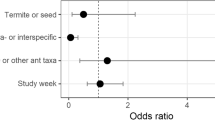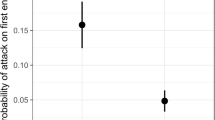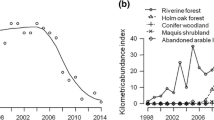Abstract
Species can coexist through equalizing (similar fitness abilities) and stabilizing (unique niche requirements) mechanisms—assuming that intraspecific competition imposes more limitation than interspecific competition. Non-native species often de-stabilize coexistence, suggesting that they bring either a fitness advantage or a distinct niche requirement. We tested whether greater fitness or unique niche requirements best explained a successful North American invasion by the European Myrmica rubra ant. North American invaded-range M. rubra aggressively sting and occur in enormous numbers (suggesting a fitness advantage), yet our study site has a history of anthropogenic disturbance that might favor M. rubra (suggesting a unique niche). We compared M. rubra to native ants, principally the dominant North American woodland ant Aphaenogaster picea, using physiological health (lipids and size), monthly bait station surveys and aggression assays to assess fitness abilities, and we used nest surveys and isotope analysis to assess niche characteristics. We confirmed the field observations with laboratory experiments that tested colony aggression (direct competition) and food retrieval (indirect competition). In both the observational and experimental investigations, we found little evidence of M. rubra interspecific competitive advantage (aggression or food retrieval) or niche differentiation. Instead, M. rubra violated the basic assumption of coexistence theory: intraspecific competition consistently was less than interspecific competition. Freed up from the costs and limitations of territorial competition, some non-native species may outcompete native species by not competing with themselves. This ‘friendly release’ from intraspecific competition provides an ecological mechanism for some successful invasions.





Similar content being viewed by others
References
Adams ES (2016) Territoriality in ants (Hymenoptera: Formicidae): a review. Myrmecol News 23:101–118
Beattie AJ (1985) The evolutionary ecology of ant-plant mutualism. Cambridge University Press, Cambridge
Berryman A, Turchin P (2001) Identifying the density-dependent structure underlying ecological time series. Oikos 92:265–270
Bertelsmeier C, Avril A, Blight O et al (2015) Different behavioural strategies among seven highly invasive ant species. Biol Invasions 17:2491–2503
Bluthgen N, Feldhaar H (2010) Food and shelter: How resources influence ant ecology. In: Lach L, Parr C, Abbott K (eds) Ant ecology. Oxford University Press, New York
Brasure D (1996) Control of an alien ant. Buffalo Museum of Science, Buffalo (Unpublished)
Brian MV (1952) The structure of a dense natural ant population. J Anim Ecol 21:12–24
Calcaterra L, Cabrera S, Briano J (2016) Local co-occurrence of several highly invasive ants in their native range: are they all ecologically dominant species? Insectes Soc 63:407–419
Cerda X, Arnan X, Retana J (2013) Is competition a significant hallmark of ant (Hymenoptera: Formicidae) ecology? Myrmecol. News 18:131–147
Chen W, Adams ES (2018) The distribution and habitat affinities of the invasive ant Myrmica rubra (Hymenoptera: Formicidae) in Southern New England. Environ Entomol 47:527–534
Chesson P (2000) Mechanisms of maintenance of species diversity. Ann Rev Ecol Syst 31:343–366
Clark JS, Soltoff BD, Powell AS et al (2012) Evidence from individual inference for high-dimensional coexistence: long-term experiments on recruitment response. PLoS One 7:e30050
Daehler CC (2001) Darwin’s naturalization hypothesis revisited. Am Nat 158:324–330
Darwin C (1859) The origin of species by means of natural selection or the preservation of favoured races in the struggle for life. Murray, London
Diez JM, Sullivan JJ, Hulme PE et al (2008) Darwin’s naturalization conundrum: dissecting taxonomic patterns of species invasions. Ecol Lett 11:674–681
Elmes GW (1973) Observations on the density of queens in natural colonies of Myrmica rubra L. (Hymenoptera: Formicidae). J Anim Ecol 42:761–771
Elmes GW (1980) Queen numbers in colonies of ants of the genus Myrmica. Insectes Soc 27:43–60
Errard C, Delabie J, Jourdan H et al (2005) Intercontinental chemical variation in the invasive ant Wasmannia auropunctata (Roger) (Hymenoptera Formicidae): a key to the invasive success of a tramp species. Naturwissenschaften 92:319–323
Felker-Quinn E, Schweitzer JA, Bailey JK (2013) Meta-analysis reveals evolution in invasive plant species but little support for Evolution of Increased Competitive Ability (EICA). Ecol Evol 3:739–751
Fournier D, de Biseau J-C, De Laet S et al (2016) Social structure and genetic distance mediate nestmate recognition and aggressiveness in the facultative polygynous ant Pheidole pallidula. PLoS One 11:e0156440
Fox J (2008) Applied regression analysis and generalized linear models. Sage, Los Angeles
Fox J, Weisberg S (2011) An R companion to applied regression. Sage, Thousand Oaks
Furst MA, Durey M, Nash DR (2011) Testing the adjustable threshold model for intruder recognition on Myrmica ants in the context of a social parasite. Proc R Soc Lond Ser B Biol Sci 279:516–522
Garnas J (2004) European fire ants on Mount Desert Island, Maine: population structure, mechanisms of competition and community impacts of Myrmica rubra L. (Hymenoptera: Formicidae). In: Ecology and environmental sciences. The University of Maine, Orono
Garnas JR, Drummond FA, Groden E (2007) Intercolony aggression within and among local populations of the invasive ant, Myrmica rubra (Hymenoptera: Formicidae), in coastal Maine. Environ Entomol 36:105–113
Garnas J, Groden E, Drummond FA (2014) Mechanisms of competitive displacement of native ant fauna by invading Myrmica rubra (Hymenoptera: Formicidae) populations. Environ Entomol 43:1496–1506
Gibb H, Hochuli DF (2004) Removal experiment reveals limited effects of a behaviorally dominant species on ant assemblages. Ecology 85:648–657
Gibb H, Johansson T (2011) Field tests of interspecific competition in ant assemblages: revisiting the dominant red wood ants. J Anim Ecol 80:548–557
Giraud T, Pedersen JS, Keller L (2002) Evolution of supercolonies: the Argentine ants of southern Europe. Proc Natl Acad Sci USA 99:6075–6079
Golivets M, Wallin KF (2018) Neighbour tolerance, not suppression, provides competitive advantage to non-native plants. Ecol Lett 21:745–759
Goodman M (2018) Experimental evidence that the non-native European fire ant alters invertebrate communities. Department of Biology, SUNY Buffalo State, Buffalo
Groden E, Drummond FA, Garnas J et al (2005) Distribution of an invasive ant, Myrmica rubra (Hymenoptera: Formicidae), in Maine. J Econ Entomol 98:1774–1784
Hicks BJ, Pilgrim BL, Marshall HD (2014) Origins and genetic composition of the European fire ant (Hymenoptera: Formicidae) in Newfoundland, Canada. Can Entomol 146:457–464
HilleRisLambers J, Adler PB, Harpole WS et al (2012) Rethinking community assembly through the lens of coexistence theory. Ann Rev Ecol Syst 43:227–248
Hölldobler B, Wilson EO (1990) The ants. Belknap, Cambridge
Holway DA (1998) Factors governing rate of invasion: a natural experiment using Argentine ants. Oecologia 115:206–212
Holway DA, Suarez AV, Case TJ (1998) Lose of intraspecific aggression in the success of a widespread invasive social insect. Science 282:949–952
Holway DA, Lach L, Suarez AV et al (2002) The causes and consequences of ant invasions. Ann Rev Ecol Syst 33:181–233
Hothorn T, Bretz F, Westfall P (2008) Simultaneous inference in general parametric models. Biometrical J. 50:346–363
Huszár DB, Larsen RS, Carlsen S et al (2014) Convergent development of ecological, genetic, and morphological traits in native supercolonies of the red ant Myrmica rubra. Behav Ecol Sociobiol 68:1859–1870
Hutchinson GE (1957) Population studies—animal ecology and demography—concluding remarks. Cold Spring Harbor Symp Quant Biol 22:415–427
Keane RM, Crawley MJ (2002) Exotic plant invasions and the enemy release hypothesis. Trends Ecol Evol 17:164–170
King JR, Tschinkel WR (2008) Experimental evidence that human impacts drive fire ant invasions and ecological change. Proc Natl Acad Sci USA 105:20339–20343
King JR, Warren RJ II, Bradford MA (2013) Social insects dominate eastern US temperate hardwood forest macroinvertebrate communities in warmer regions. PLoS One 8:e75843
Krushelnycky PD, Holway DA, LeBrun EG et al (2010) Invasion processes and causes of success. In: Lach L, Parr C, Abbott K (eds) Ant ecology. Oxford University Press, New York
Levine JM, Vila M, D’Antonio CM et al (2003) Mechanisms underlying the impacts of exotic plant invasions. Proc R Soc Lond Ser B Biol Sci 270:775–781
Lotka AJ (1924) Elements of physical biology. Williams and Wilkins, Baltimore
Lubertazzi D (2012) The biology and natural history of Aphaenogaster rudis. Psyche 2012:752815
MacDougall AS, Gilbert B, Levine JM (2009) Plant invasions and the niche. J Ecol 97:609–615
Naumann K, Higgins RJ (2015) The European fire ant (Hymenoptera: Formicidae) as an invasive species: impact on local ant species and other epigaeic arthropods. Can Entomol 147:592–601
Ouellette GD, Drummond FA, Choate B et al (2010) Ant diversity and distribution in Acadia National Park, Maine. Environ Entomol 39:1447–1456
Parr CL, Gibb H (2009) Competition and the role of dominant ants. In: Lach L, Parr CL, Abbott KL (eds) Ant ecology. Oxford University Press, Oxford, pp 77–96
Parr CL, Gibb H (2011) The discovery–dominance trade-off is the exception, rather than the rule. J Anim Ecol 81:233–241
Petal J (1967) Productivity and the consumption of food in the Myrmica laevinodis populations. In: Petrusewicz K (ed) Secondary productivity of terrestrial ecosystems. Polish Academy of Sciences, Warsaw, pp 841–858
R Core Team Version 3.5.0 (2018) R: a language and environment for statistical computing, 3.5.0 edn. R Foundation for Statistical Computing, Vienna
Roulston TH, Buczkowski G, Silverman J (2003) Nestmate discrimination in ants: effect of bioassay on aggressive behavior. Insectes Soc 50:151–159
Sanders NJ, Suarez AV (2011) Elton’s insights into the ecology of ant invasions: lessons learned and lessons still to be learned. In: Richardson DM (ed) Fifty years of invasion biology: the legacy of Charles Elton. Wiley, West Sussex
Sanders NJ, Gotelli NJ, Heller NE et al (2003) Community disassembly by an invasive species. Proc Natl Acad Sci USA 100:2474–2477
Savolainen R, Vepsalainen K (1988) A competition hierarchy among boreal ants: impact on resource partitioning and community structure. Oikos 51:135–155
Seppa P (1996) Genetic relatedness and colony structure in polygynous Myrmica ants. Ethol Ecol Evol 8:279–290
Stachowicz JJ, Tilman D (2005) Species invasions and the relationships between species diversity, community saturation, and ecosystem functioning. In: Sax DF, Stachowicz JJ, Gaines SD (eds) Species Invasions: Insights into ecology, evolution, and biogeography. Sinauer, Sunderland, pp 41–64
Stevens MHH (2009) A primer of ecology with R. Springer, New York
Suarez AV, Tsutsui ND, Holway DA et al (1999) Behavioral and genetic differentiation between native and introduced populations of the Argentine ant. Biol Invasions 1:43–53
Suarez AV, Holway DA, Case TJ (2001) Patterns of spread in biological invasions dominated by long-distance jump dispersal: insights from Argentine ants. Proc Natl Acad Sci USA 98:1095–1100
Suarez AV, Holway DA, Tsutsui ND (2008) Genetics and behavior of a colonizing species: the invasive Argentine ant. Am Nat 172:S72–S84
Tillberg CV, McCarthy DP, Dolezal AG et al (2006) Measuring the trophic ecology of ants using stable isotopes. Insectes Soc 53:65–69
Tschinkel WR (2006) The fire ants. Harvard University Press, Cambridge
Tsutsui ND, Suarez AV, Holway DA et al (2000) Reduced genetic variation and the success of an invasive species. Proc Natl Acad Sci USA 97:5948–5953
van der Hammen T, Pederson JS, Boomsma JJ (2002) Convergent development of low-relatedness supercolonies in Myrmica ants. Heredity 89:83–89
Volterra V (1931) Lessons on the mathematical theory of the struggle for life (Original: Leçons sur la théorie mathématique de la Lutte pour la vie). Gauthier-Villars, Paris
Wardlaw JC, Elmes GW (1996) Exceptional colony size in Myrmica species (Hymenoptera: Formicidae). Entomologist 115:191–196
Warren RJ II, Giladi I, Bradford MA (2012) Environmental heterogeneity and interspecific interactions influence occupancy be key seed-dispersing ants. Environ Entomol 41:463–468
Warren RJ II, McMillan A, King JR et al (2015) Forest invader replaces predation but not dispersal services by a keystone species. Biol Invasions 23:3153–3162
Warren RJ II, King J, Chick LD et al (2017) Global change impacts on ant-mediated seed dispersal in eastern North American forests. In: Oliveira PS, Koptur S (eds) Ant-plant interactions. Cambridge University Press, Cambridge
Warren RJ II, Candeias M, Labatore AC et al (2018a) Multiple mechanisms in woodland plant species invasion. J Plant Ecol. https://doi.org/10.1093/jpe/rty010
Warren II RJ, Mathew A, Reed K, et al. (2018b) Myrmica rubra microhabitat selection and putative ecological impact. Ecol Entomol. https://doi.org/10.1111/een.12700
Wetterer JK, Radchenko AG (2011) Worldwide spread of the ruby ant, Myrmica rubra (Hymenoptera: Formicidae). Myrmecol News 14:87–98
Wheeler WM (1908) A European ant (Myrmica laevinodis) introduced into Massachusetts. J Econ Entomol 1:336–339
Acknowledgements
Support for this research was provided by the SUNY Buffalo State Office of Undergraduate Research. The authors would like to thank Zandra Wills, Nalah Joseph, Kazz Archibald, Connor Blizzard, Mike Olejniczak, Rabiyah Irfan, Rhudwan Nihlawi and Sonya Bayba for field and laboratory assistance. We also are grateful to Don Brasure and Wayne Gall for collecting data on Tifft ants in the 1990s. We thank two anonymous reviewers for helpful comments on the manuscript. The authors also thank the Buffalo Museum of Science and Tifft Nature Preserve for permission to conduct field research.
Author information
Authors and Affiliations
Contributions
RW conceived the ideas and designed methodology; KR, AM, KK and MG collected the data; RW and DS supervised data collection. RW led the writing of the manuscript. All authors contributed critically to the drafts and gave final approval for publication.
Corresponding author
Ethics declarations
Data accessibility
The data generated and analyzed for the current study are available in the SUNY Buffalo State Digital Commons [http://digitalcommons.buffalostate.edu/biology_data/4].
Electronic supplementary material
Below is the link to the electronic supplementary material.
Rights and permissions
About this article
Cite this article
Warren, R.J., Reed, K., Mathew, A. et al. Release from intraspecific competition promotes dominance of a non-native invader. Biol Invasions 21, 895–909 (2019). https://doi.org/10.1007/s10530-018-1868-z
Received:
Accepted:
Published:
Issue Date:
DOI: https://doi.org/10.1007/s10530-018-1868-z




